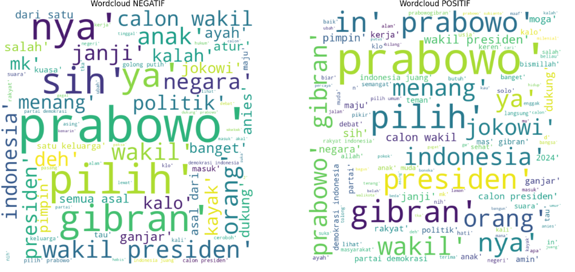Main Article Content
Abstract
The 2024 presidential election has attracted considerable attention as it has become a controversial issue among the public. Various positive and negative opinions generated can potentially turn into rumors. One of the means used by the public to express their opinions is the social media platform Instagram. Data on public opinions on Instagram can be processed into valuable information through sentiment classification. This research conducted sentiment classification on public perceptions towards the 2024 presidential candidates using a naïve Bayes classifier. The study utilized a dataset consisting of 1000 comments. These comments were collected from several posts on the social media platform Instagram discussing the presidential and vice-presidential candidates. The comments were manually labeled by an expert who is a lecturer in the Indonesian language. Classification was carried out after preprocessing and weighting TF-IDF stages. Based on the research findings, the naïve Bayes classifier method showed an accuracy of 82% and an F1-Score of 83.93% obtained from a 90%:10% split of training and testing data. These results indicate that the naïve Bayes classifier method is effective in classifying the sentiments of the public on Instagram towards the 2024 presidential candidates.
Keywords
Article Details

This work is licensed under a Creative Commons Attribution-NonCommercial 4.0 International License.
References
- O. Manullang and C. Prianto, “Analisis Sentimen dalam Memprediksi Hasil Pemilu Presiden dan Wakil Presiden : Systematic Literature Review,” vol. 04, no. 02, pp. 104–113, 2023.
- M. I. Baktora, “Pro dan Kontra Gibran Rakabuming Raka jadi Cawapres di Pemilu 2024, Bagaimana Pandangan Kaum Muda, Yakin Banyak Dipilih?” Accessed: Mar. 04, 2024. [Online]. Available: https://www.suara.com/kotaksuara/2023/11/24/170000/pro-dan-kontra-gibran-rakabuming-raka-jadi-cawapres-di-pemilu-2024-bagaimana-pandangan-kaum-muda-yakin-banyak-dipilih
- K. Makasar, “Pro Kontra Putusan MK, Gerindra: Ada Operasi Senyap Jegal Gibran Maju di Pilpres,” KompasTV. Accessed: Dec. 07, 2023. [Online]. Available: https://www.kompas.tv/regional/458338/pro-kontra-putusan-mk-gerindra-ada-operasi-senyap-jegal-gibran-maju-di-pilpres
- D. Normawati and S. A. Prayogi, “Implementasi Naïve Bayes Classifier Dan Confusion Matrix Pada Analisis Sentimen Berbasis Teks Pada Twitter,” J. Sains Komput. Inform. (J-SAKTI, vol. 5, no. 2, pp. 697–711, 2021.
- S. Juanita, “Analisis Sentimen Persepsi Masyarakat Terhadap Pemilu 2019 Pada Media Sosial Twitter Menggunakan Naive Bayes,” J. Media Inform. Budidarma, vol. 4, no. 3, p. 552, 2020, doi: 10.30865/mib.v4i3.2140.
- A. Halim, Y. Yusra, M. Fikry, M. Irsyad, and E. Budianita, “Klasifikasi Sentimen Masyarakat Di Twitter Terhadap Prabowo Subianto Sebagai Bakal Calon Presiden 2024 Menggunakan M-KNN,” J. Inf. Syst. Res., vol. 5, no. 1, pp. 202–212, 2023, doi: 10.47065/josh.v5i1.4054.
- M. R. Fais Sya’ bani, U. Enri, and T. N. Padilah, “Analisis Sentimen Terhadap Bakal Calon Presiden 2024 Dengan Algoritme Naïve Bayes,” JURIKOM (Jurnal Ris. Komputer), vol. 9, no. 2, p. 265, 2022, doi: 10.30865/jurikom.v9i2.3989.
- M. S. Sulasno and H. Amalia, “Analisis Sentimen Opini Masyarakat Indonesia Terhadap Vaksin Covid-19 Pada Sosial Media Twitter Menggunakan Metode Naïve Bayes dan k- Nearest Neighbors,” vol. 1, no. 1, 2022.
- P. Pandunata, C. K. Ananta, and Y. Nurdiansyah, “Analisis Sentimen Opini Publik Terhadap Pekan Olahraga Nasional Pada Instagram Menggunakan Metode Naïve Bayes Classififer,” INFORMAL Informatics J., vol. 7, no. 2, p. 146, 2022, doi: 10.19184/isj.v7i2.33928.
- W. Bourequat and H. Mourad, “Sentiment Analysis Approach for Analyzing iPhone Release using Support Vector Machine,” Int. J. Adv. Data Inf. Syst., vol. 2, no. 1, pp. 36–44, 2021, doi: 10.25008/ijadis.v2i1.1216.
- K. Anwar, “Analisa sentimen Pengguna Instagram Di Indonesia Pada Review Smartphone Menggunakan Naive Bayes,” KLIK Kaji. Ilm. Inform. dan Komput., vol. 2, no. 4, pp. 148–155, 2022, doi: 10.30865/klik.v2i4.315.
- A. Rahman, E. Utami, and S. Sudarmawan, “Sentimen Analisis Terhadap Aplikasi pada Google Playstore Menggunakan Algoritma Naïve Bayes dan Algoritma Genetika,” J. Komtika (Komputasi dan Inform., vol. 5, no. 1, pp. 60–71, 2021, doi: 10.31603/komtika.v5i1.5188.
- R. L. Musyarofah, E. U. Utami, and S. R. Raharjo, “Analisis Komentar Potensial pada Social Commerce Instagram Menggunakan TF-IDF,” J. Eksplora Inform., vol. 9, no. 2, pp. 130–139, 2020, doi: 10.30864/eksplora.v9i2.360.
- Sintia, S. Defit, and G. W. Nurcahyo, “Product Codefication Accuracy With Cosine Similarity and Weighted Term Frequency and Inverse Document Frequency (Tf-Idf),” J. Appl. Eng. Technol. Sci., vol. 2, no. 2, pp. 14–21, 2021, doi: 10.37385/jaets.v2i2.210.
- R. Wati, S. Ernawati, and H. Rachmi, “Pembobotan TF-IDF Menggunakan Naïve Bayes pada Sentimen Masyarakat Mengenai Isu Kenaikan BIPIH,” J. Manaj. Inform., vol. 13, no. 1, pp. 84–93, 2023, doi: 10.34010/jamika.v13i1.9424.
- “Implementasi Data Mining Menggunakan Metode NaãVe Bayes Classifier Untuk Data Kenaikan Pangkat Dinas Ketenagakerjaan Kota Medan,” J. Sci. Soc. Res., vol. 5, no. 1, p. 85, 2022, doi: 10.54314/jssr.v5i1.804.
- M. Ismali, N. Hassan, and S. S. Bafjaish, “Comparative Analysis of Naive Bayesian Techniques in Health-Related for Classification Task,” J. Soft Comput. Data Min., vol. 1, no. 2, pp. 1–10, 2020
- E. Hasibuan and E. A. Heriyanto, “Analisis Sentimen Pada Ulasan Aplikasi Amazon Shopping Di Google Play Store Menggunakan Naive Bayes Classifier,” J. Tek. dan Sci., vol. 1, no. 3, pp. 13–24, 2022, doi: 10.56127/jts.v1i3.434.
- Y. A. Singgalen, “Penerapan Metode CRISP-DM dalam Klasifikasi Data Ulasan Pengunjung Destinasi Danau Toba Menggunakan Algoritma Naïve Bayes Classifier (NBC) dan Decision Tree (DT),” J. Media Inform. Budidarma, vol. 7, no. 3, pp. 1551–1562, 2023, doi: 10.30865/mib.v7i3.6461.

